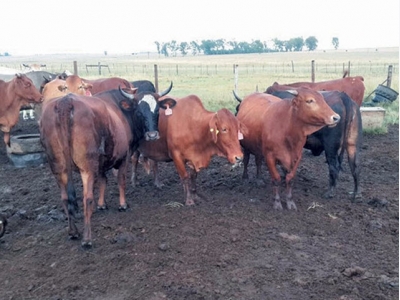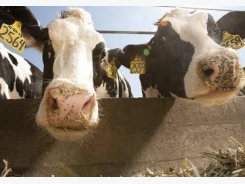Artificial insemination: ideal for communal farmers

Communal farmers can benefit from using more advanced farming practices, such as artificial insemination (AI), to improve herd genetics. Basimane Makgetla spoke to Gerhard Uys about how AI has worked for him as a weekend communal farmer running a small, but improving, herd.
Basimane Makgetla bought a group of mixed-breed cows, but is improving the genetics of his herd by using artificial insemination. Photo: Gerhard Uys
In 2015, Basimane Makgetla bought a 19-strong cow herd to run on communal land near Putfontein in North West, and his first calves were born very recently.
What makes these calves unusual is that they were conceived using artificial insemination (AI), a method very seldom employed by communal farmers.
Basimane, who has a BCom (Law) degree and is currently studying towards an MBA, lives in Johannesburg, 200km away.
He works as a business process specialist for a telecoms company in Midrand, Gauteng.
A dream come true
Basimane’s connection with the land at Putfontein goes back several generations; his parents and their entire community were forced off the land in 1976 and moved to Mahikeng by the apartheid government.
In 2004, the land was returned to the community as part of the land restitution process, and many community members and former residents returned to start afresh.
Basimane’s grandfather had always owned cattle, and although the herd was supposed to become the family’s property after his death, this never happened. However, it was always Basimane’s dream to farm, and in 2015, he took the first steps to turn this into reality.
After attending a beef production course at the Agricultural Research Council (ARC) in Pretoria, he took a year off from his job to volunteer there and “invest in agricultural skills”. He wanted to see whether he was cut out for a profession he knew very little about, but with which he was somehow infatuated.
While attending the course, Basimane came to the conclusion that AI could solve many bull-related difficulties faced by communal farmers. These include sexually transmitted diseases in particular, but there are many others.
“Bulls often impregnate cows elsewhere if not looked after properly. Stock theft is also rife. And when a bull isn’t looked after in a communal area he wanders off, and is often found injured or sick,” he says.
In addition, explains Basimane, if a proper breeding season is followed, a bull is used for only about two months of the year, so using AI saves money and grazing.
After having learnt about its advantages, Basimane decided to use AI technology to establish his herd, despite running the animals on communal land and having limited infrastructure. He approached Nkunzi Genetics, which assists new producers with AI needs, and chose Bonsmara semen.
“Nkunzi Genetics gave me a catalogue to select a bull, but I gave Joel Nkuna [the owner] specifics in terms of what I wanted: ease of calving, good feed conversion, and adaptability to the tough environment. The area can be dry and hot, so this was a priority.
“When you have a [business processes background], you expect processes and systems and good working procedures. Those who look after my few head of cattle have a good understanding of what must happen when a calf is born and how it must be treated,” Basimane says.
He recently attended a talk by local vet, Dr Danie Odendaal, who explained that due to the drought and the consequent decline in cows’ condition, only 50% of cows in South Africa were expected to come on heat.
But Basimane says that if cows are ‘synchronised’ for AI using hormone treatment, those who do not conceive following AI are still guaranteed to come on heat and can be put to a bull.
He plans to continue using AI. “Even if someone tells me now they have R35 000 for me to buy a bull, I’d rather invest it in AI. The department of agriculture has assisted many farmers in our area with subsidies for bulls, but resources are limited.
I believe government should invest in smallholders by providing AI services and training them to [administer] it. They can also provide an AI start-up kit which wouldn’t cost more than R20 000,” he says.
New approach
Despite farming on communal land, Basimane wants to farm differently from the way in which his grandfathers and many older people in the community did.
The ARC conducts ongoing research into new farming technologies, and he is determined to take advantage of the latest farming practices.
“I knew I wanted to push quality and farm profitably. I wanted Bonsmara cattle, but couldn’t afford them. Again, AI turned out to be the answer,” he says.
Working together
Farming on communal land is difficult enough as it is; being a weekend farmer and far away from his cattle has made the task even tougher for Basimane. But the assistance received from a number of fellow farmers has enabled Basimane to farm sustainably.
Two local, communal farmers who have been invaluable to him, as well as other communal farmers in the area, are brothers Belfast and Aubrey Makgeledise, who regularly assist with advice and infrastructure needs.
In addition, one of Belfast’s labourers keeps an eye on Basimane’s herd, and moves the cattle around to areas where grazing looks promising.
His cousin, Tebogo Matlhaba, also helped build a kraal for his cattle. Aspiring beef farmer, Khepi Shole, is the last member of the group. The farmers collaborate on aspects such as AI and other farming practices with the ultimate aim of making them all more profitable.
The members also share the costs of labour, semen and hormones used for synchronisation, which is about R350/cow per insemination.
The farmers know the area well and advise Basimane about inoculation programmes that are specific to different seasons. Both Belfast and Aubrey have herds that are more than 100-head strong.
According to Basimane, all members of the group are open to new farming ideas to bring about greater profitability, and are starting to sell cattle to feedlots, even if it is only a calf or two at a time.
Although working together has made life easier, the members of the group agree there is a need to train farmworkers to ensure that they acquire new skills.
Basimane says that he has been amazed by the help he has received from others, even outside the communal area. One incident in particular stands out: while he was transporting cows between Mahikeng and Coligny, his trailer overturned outside Lichtenburg.
After the accident, the cows made their way to the side of the road, but one animal was severely injured. The farmer, Gielie Nel, came to assist and herded the cattle onto his land where he kept them until Tebogo (Basimane’s cousin) arrived with another trailer some hours later.
Gielie then offered Basimane the use of his loading ramp and insisted on taking care of the injured cow, which he supplied with feed and water for a number of days. Unfortunately, the animal had to be put down.
“He didn’t know me or even know if my cattle could bring diseases onto his farm. But he helped me,” Basimane recalls.
Infrastructure needs
Theft has been one of the challenges faced by the group. Their camp fencing has been stolen and Basimane says it will be costly to erect new fences, especially as there is no guarantee that thieves won’t strike again.
Existing infrastructure in the area includes a crush, and the group’s members have joined forces to invest in new infrastructure.
“We invested in a JoJo tank and water pump, all sharing in the costs. We also bought a generator so we can pump water to kraals at night,” Basimane says.
The way forward
Basimane has joined the ARC’s beef improvement scheme, and receives assistance with keeping production records, weighing calves and recording growth.
For the moment, he plans to sell all bull calves born, but retain heifers to build herd numbers.
He will, however, use AI exclusively to ensure that he builds a good genetic base. His long-term goals include selling all his cows and investing in Bonsmara cows.
Ultimately, his wish is to own his own farm where he can be in complete control of production. Luckily, he has the full support of his wife, Sessy, and children, Loago and Tlotlo, who take an active role in farm activities.
Basimane tries to visit his cattle as often as possible. At the moment, a building on the property serves as shared accommodation for when he visits.
The members of the group also share responsibilities during the festive season, with some going on holiday, while others remain behind to tend to production needs.
Có thể bạn quan tâm
Phần mềm

Phối trộn thức ăn chăn nuôi

Pha dung dịch thủy canh

Định mức cho tôm ăn

Phối trộn phân bón NPK

Xác định tỷ lệ tôm sống

Chuyển đổi đơn vị phân bón

Xác định công suất sục khí

Chuyển đổi đơn vị tôm

Tính diện tích nhà kính

Tính thể tích ao hồ




 Donkey farming: opportunity or threat?
Donkey farming: opportunity or threat?  Don’t play guessing game: Know cow's bodyweight
Don’t play guessing game: Know cow's bodyweight